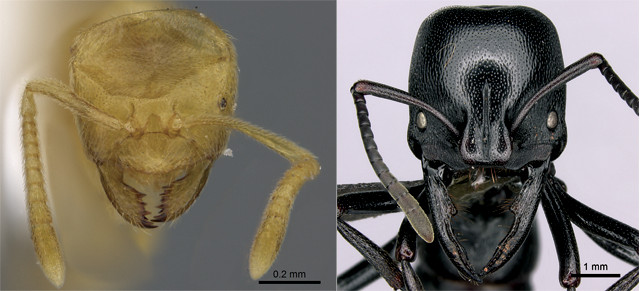
by Kate S. Zalzal Tuesday, December 27, 2016

Environmental conditions such as temperature and UVB exposure help determine the coloration of ant species — dark or light— that predominate in an area. Credit: left: Shannon Hartman, www.antweb.org, CC BY 4.0; right: Will Ericson, www.antweb.org, CC BY 4.0.
Ants are ectotherms, which means their metabolisms are controlled by the temperature of their environment. New research shows that the environment also influences their color and size.
Researchers led by Tom Bishop, then a graduate student in ecology at the University of Liverpool in England, found that ants with larger body sizes were darker in color than those with smaller body sizes. Ant assemblages also became lighter in color with increasing temperature, such that larger and darker ants generally lived in colder locations while smaller, lighter ants lived in warmer locations.
Bishop’s team collected data on climate, temperature and ultraviolet-B (UVB) radiation levels from 14 sites across South Africa, South America and Australia, along with data on 592 species of ants, including abundance, color and body size.
The color-temperature relationship held for variations in year-to-year temperature, with darker species more abundant in cooler years and lighter species more abundant in warmer years. One exception, however, occurred at sites with the highest temperatures and high UVB levels, where darker ants were found. The dark coloration could act as sunblock, offering protection from damaging UVB rays, the authors reported in Global Ecology and Biogeography.
“These results help us to understand why ant species are distributed in the way that they are across the globe, but also highlight that, as the climate changes, there may be certain ways in which the ants respond,” said Bishop, now a postdoctoral fellow at the University of Pretoria in South Africa, in a statement. “On a warmer planet, for example, we would expect that smaller and lighter-colored ants will come to predominate and this may have important cascading effects on ecosystems as different ants have different functions.”
© 2008-2021. All rights reserved. Any copying, redistribution or retransmission of any of the contents of this service without the expressed written permission of the American Geosciences Institute is expressly prohibited. Click here for all copyright requests.